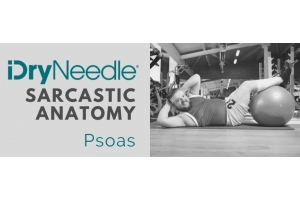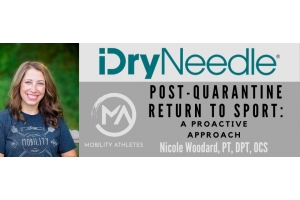

“Should I use dry needling before or after other manual techniques?”
A good question – and one we get on courses all the time.
“Should I use dry needling before or after other manual techniques?”
I’ll defuse the potential e-bomb right now and say this is clearly an “it depends” answer. It depends on a lot actually…diagnosis, condition chronicity, severity, complexity, your treatment model, your expertise – but largely it depends on the individual patient in front of you. This will always be the #1 factor in our clinical decision-making and implementation of any technique or modality.
And for now let’s just pretend to mutually agree that movement and exercise is best employed after all of these manual techniques – I know there may be great examples on why correctives may be best before manual therapies, but let’s save that for a separate post.
Beyond that, let’s go over some initial consideration which might help you decide if using dry needling before or after your other manual techniques is best. And for other “manual techniques” I’m thinking soft tissue work, instrument-assisted methods, ART, joint mobilization, manipulation, etc.

3 things to consider
1) How much time do you have?
It’s sad this would factor into clinical-decision making, because most PTs would like to think we will do anything and everything possible to help our patients, for as long as that may take. But we all know the reality of having 20, 30, or 45-minute sessions with a multi-modal treatment strategy and basing some clinical decisions on “time left” during a session.
Here are my thoughts – If you have less than 30 minutes with your patient, aside from an initial reassessment and pre-test of their current status; and assuming dry needling is an appropriate part of the mutually established treatment plan – think of 2-4 needles to do FIRST, before other manual treatments. Most appreciate dry needling as a less time-intensive modality (compared to other soft tissue treatments), but considering ANY manual technique we employ is input to our patient’s system and CNS – needling is perhaps the most precise, impactful, and efficient input we can give in a small window of time. From there other manual techniques can be used to minimize post-treatment soreness, address residual impairments, or to reinforce changes made with the needle. Then get them moving (this will be a theme).
2) Where does your expertise lie?
It might sound silly to endorse doing what you’re good at – but it’s kind of true. If joint mobilization, manipulative or ART techniques are your forte (and you can effectively communicate this to your patient), then this should be your first effort and needling can be introduced as a secondary treatment option either in future sessions or to quickly address more localized issues afterwards. I will say as a former “joint-jockey”, I have found that needling first has made other techniques easier, more comfortable, or less necessary overall…but this is entirely preferential.
3) What is your goal with needling?
Let’s think one level deeper than “getting my patient to move better with less pain” – even though that is 100% the best goal to have for any PT session. Here I mean, is the intent of this needle in thisneedle session to…reduce pain, to improve ROM, to restore specific muscle function, to improve region motor control, reduce spasticity, combat atrophy, edema evacuation, tissue remodeling, blood flow? With too many scenarios to go through one-at-a-time, I’ll simply leave this as the last aspect to consider when deciding whether to needle first, last, or not at all.

With these initial considerations in place, let’s discuss more specific patient populations and how you might introduce dry needling into a treatment plan or session. And again under the massive umbrella of IT DEPENDS…I’m presenting this like a rapid-fire “what would you do?” sort of commentary.
Chronic pain
Not my area of expertise, but polling some brilliant colleagues who specialize with the populations of persistent pain and 10+, 15+ and 20+ years of pain - there seemed to be a unanimous recommendation. Needling first may allow optimal duration or maximize therapeutic and analgesic effect, but also gives you some time to recover with other techniques or modalities if the soreness afterwards is perceived as a negative treatment effect to the patient. Essentially you don’t want a great session ruined by them perseverating on that upper trap needle you did right before they walked out the door. Furthermore, this population is highly variable both inter-personally and intra-personally. Just because one treatment style or dose worked for one person, doesn’t mean it will work for another. And even if there was success using dry needling last session with this person doesn’t mean it will work on all sessions with this same person. But those of you who know this, already know this – not just in terms of dry needling response.
Acute low back injury
Can you picture this patient? The new patient that calls distraught and asks if you have any openings in the next hour or two, fills out their intake paperwork leaned up against the front desk, and labors to get back to the treatment room. Once I’ve determined this patient is appropriate for my clinic and they are on board with “anything that will help” including my description of needling – I will definitely treat them with dry needling. The “it depends” spectrum here is mostly based on patient tolerance, positioning, and the enigma of other factors which guide us to either conservatively or aggressively treat an acute injury. If this truly is an acute injury, my patient explanation of the treatment may focus less on improving local histological tissue health and more on the cortical analgesic effect of calming the ramped up CNS “den mother” which is now on high alert for ANY movement to cause five-alarm pain. But in my head I’m evaluating if the pain is from intervertebral annular tearing, tendinous involvement of the lumbosacral region, or if the chemoreceptors of a nerve root are being bathed in the biochemical “battery acid” following an injury. Hopefully this has painted a picture much different than the patient with chronic low back pain. For this patient with an acute low back injury, I personally would needle (as tolerated) first and potentially follow more of a pain relief stim protocol of low frequency (2-5 Hz), long duration (15-20 minutes).
Return to sport
Our hope is that in the later rehab stages and potentially healthier, less sensitized systems of an athlete returning to sport – we/they will become less reliant on passive modalities and a more exercise-based functional emphasis will be enough to mitigate minor impairments and continue improvement towards specific therapy goals. Guess what? Exercise, loading/unloading of weight-bearing joints, and patterned movement is all input too. Maybe modalities (like needling) needed to break the cycle initially, are no longer needed. Consider using needling as more of a back-up treatment option at this point.
Acute soft tissue injury
This is probably the most variable category but none-the-less one of the other more common questions that comes up on courses. We are talking muscle strains and ankle sprains. The “it depends” answer here depends (to me) on - 1) the graded severity of the injury and, 2) how much you trust your patient. To clarify - following an evaluation, I educate my patient on their injury, the stages of tissue healing in context of their injury, and factors which will either expedite or delay that general healing timeline. Since we are talking specifically an acute injury, if I don’t trust that this patient will allow this tissue to heal appropriately in the acute phase – then I will hold off on needling, a modality which may decrease pain, improve mobility, and ultimately tempt them to pre-maturely return to sport sooner than recommended. I’ll default to my other manual techniques, taping, thermal modalities, and controlled pain-free movements for this short “acute” window – once the epithelial and tissue-healing cascade is on its way, needling will typically become primary in the subacute phase during movement/exercise progression. These timeframes, my recommendations and management will certainly be different for grade 1 vs grade 2…for now we aren’t getting into grade 3 talk.
CONCLUSION (DISCLAIMER)
Anytime a clinical commentary attempts to answer a question as black and white, controversy ensues. If anything this post is my personal preference to stimulate an ongoing reflective critical appraisal of risk/benefit with any patient considering the use of dry needling – it’s not meant to change or dictate clinical decisions, especially in regards to a highly-specialized and invasive technique like dry needling. Be smart. Be safe. And always remember our goal is to help people live happier, healthier lives.
Thanks for reading!
Paul Killoren PT, DPT









